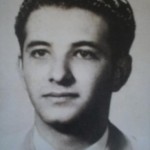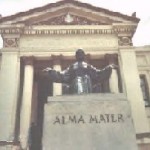CUBA- October 1959 – The University student elections gave Fidel Castro an opportunity to avenge past grievances.
The most popular candidate for the presidency was Pedro Luis Boitel, an engineering student. Sickly as a youth, Boitel had had to work from an early age to put himself through secondary school and the university. He opposed Batista after March 1952 and went to Venezuela returning to Havana in January 1959. Weak of body, he had an indomitable spirit of independence, much admired by his classmates.
Major Rolando Cubelas, had served in Las Villas with the Revolutionary Directorate. Castro sent him to Prague as military attache and then, assured of his loyalty, allowed him to return to the university, ostensibly as a medical student. He had the strong backing of Raul Castro and Ernesto Guevara. Cubelas had kept his beard,and, like the prime minister, he continued to wear his uniform, even on the campus. Running on the same ticket as Angel Quevedo, a lieutenant in the Revolutionary Directorate, who only recently had been promoted by Castro to the rank of major.
Fidel Castro would permit no independent student government, and he knew that Boitel could win any free election. On the morning of the balloting – Saturday, October 17 – Revolucion published a statement from the prime minister, calling for unity in the ranks of the revolutionaries. The sole division in Cuba, he said whether among peasants, workers, or students, must be between those who stood with the revolution and those who opposed it. There was no middle ground, no neutrality. If the country’s laborers worked nine hours a day, if the peasants tilled the fields from sunup to sundown, surely the students could make sacrifices as well, he said. Instead of fighting among themselves, they should give each other a “revolutionary embrace,” should proclaim a president unanimously and unite in a true plan of reform that could be carried out with no delay. The Maximum Leader’s intent came through loud and clear. Boitel immediately withdrew his candidacy.
Yet many students defied the prime minister and cast their votes for Boitel anyway. He carried five of the thirteen schools. Cubelas took office on October 20 and began to savor the perquisites of revolutionary power. He appointed thirteen friends as paid secretaries with duties in fields of foreign affairs, social and economic relations, and industries and culture. He wore tailored uniforms and drove a large automobile. He also assigned cars to his friends. Though a power at the university, he was rarely on campus. He was seen most often driving around Havana with women of “dubious reputation.” On October 28 the university council accepted a system of co-government with the FEU leaders. In reality the professors and deans had lost their authority to make decisions and served only as a conduit to transmit information to the cabinet. Castro had destroyed democracy and autonomy on the university campus.
A year later Boitel was sentenced to a long prison term for “anti-revolutionary” crimes. He arrived at the prison carrying a large crucifix. It was taken from him. He died on a hunger strike. In 1966 Cubelas too went to prison, charged with planning to assassinate the Maximum Leader.
Sources: FreeCuba/Castro/Quirk/
InternetPhotos/www.TheCubanHistory.com
CUBA’S UNIVERSITY AUTONOMY Ended (Oct.1959)
The Cuban History, Hollywood.
Arnoldo Varona, Editor
Ciudad de Baracoa. Guantánamo
Foto por Cecilia Habanera with Rayner Fleites.- Ciudad de Baracoa.

EL FINAL DE AUTONOMÍA UNIVERSITARIA (octubre 1959)
CUBA, Octubre 1959 – Las elecciones estudiantiles Universitarias dio a Fidel Castro una oportunidad de vengar los agravios del pasado.
El candidato más popular para la presidencia fue Pedro Luis Boitel, estudiante de ingeniería. Enfermizo en su juventud, Boitel había tenido que trabajar desde muy temprana edad para ponerse en la escuela secundaria y la universidad. Se opuso a Batista después de marzo de 1952 y se fue a Venezuela de regresar a La Habana en enero de 1959. Débil de cuerpo, que tenía un espíritu indomable de la independencia, muy admirado por sus compañeros de clase.
Los principales Cubelas Rolando, había servido en Las Villas, con el Directorio Revolucionario. Castro le envió a Praga como agregado militar y, a continuación, seguro de su lealtad, le permitió regresar a la universidad, aparentemente como un estudiante de medicina. Él tenía el fuerte respaldo de Raúl Castro y Ernesto Guevara. Cubelas había mantenido su barba, y, al igual que el primer ministro, que continuó usando su uniforme, incluso en el campus. Correr en el mismo billete como Angel de Quevedo, un teniente en el Directorio Revolucionario, que sólo recientemente había sido ascendido por Castro para el rango de mayor.
Fidel Castro permitiría que ningún gobierno independiente del estudiante, y sabía que podía ganar Boitel cualquier elección libre. En la mañana de la votación – Sábado, 17 de octubre – Revolución publicó una declaración del primer ministro, llamando a la unidad en las filas de los revolucionarios. La división única en Cuba, dijo que si entre los campesinos, trabajadores o estudiantes, debe estar entre los que estaban con la revolución y los que se opusieron a ella. No había término medio, no hay neutralidad. Si los trabajadores del país trabajaron nueve horas al día, si los campesinos cultivaban los campos de sol a sol, sin duda los alumnos pueden hacer sacrificios, así, dijo. En lugar de luchar entre sí, deben darse un “abrazo revolucionario”, debe proclamar un presidente por unanimidad y se unen en un verdadero plan de reforma que podría llevarse a cabo sin demora. La intención del Máximo Líder se escuchó fuerte y claro. Boitel inmediatamente retiró su candidatura.
Sin embargo, muchos estudiantes desafiaron al primer ministro y emitir sus votos para Boitel de todos modos. Llevaba cinco de las trece escuelas. Cubelas asumió el cargo el 20 de octubre y comenzó a saborear las prebendas del poder revolucionario. Él designó a trece amigos como secretarios pagados con funciones en materia de asuntos exteriores, relaciones sociales y económicas, y las industrias y la cultura. Se vestían uniformes adaptados y conducía un automóvil grande. También asigna los coches a sus amigos. A pesar de un poder en la universidad, él rara vez estaba en el campus. Se le vio más a menudo en coche por La Habana con las mujeres de “dudosa reputación”. El 28 de octubre el Consejo Universitario aceptó un sistema de co-gobierno con los dirigentes de la FEU. En realidad, los profesores y decanos había perdido su autoridad para tomar decisiones y sólo sirve como un conducto para transmitir la información al gabinete. Castro había destruido la democracia y la autonomía en el campus universitario.
Un año más tarde Boitel fue condenado a una larga pena de cárcel para los “anti-revolucionarios” los crímenes. Llegó a la carcel con un gran crucifijo. Fue tomado de él. Él murió en una huelga de hambre. En 1966, Cubelas también fue a la cárcel, acusado de planear el asesinato del líder máximo.
Sources: FreeCuba/Castro/Quirk/
InternetPhotos/www.TheCubanHistory.com
CUBA’S UNIVERSITY AUTONOMY Ended (Oct.1959)
The Cuban History, Hollywood.
Arnoldo Varona, Editor






